Letter from the Editor
A few months ago I visited an engine repair facility on behalf of a client. His engine was in the process of being rebuilt after it had suffered a loss of oil pressure. I’ve done business with this shop for nearly 20 years and while it’s only 45 minutes from my office, and from the yard I once managed, I’ve never had the opportunity to pay them a visit, until now. It’s located in a heavily wooded, rural area at the end of a dirt road. The outside of the building and surrounding grounds are non-descript. My impression changed, however, as soon as I walked into the shop. While the engine was a basket case, predictably all the bearings had been wiped out and the crankshaft cracked, the shop was immaculate, as neat as the proverbial pin, the floor a gleaming gloss gray. An excerpt of the note I sent the owner after my visit included the following…
“After all these years of doing business together, I very much enjoyed finally meeting you yesterday. As an aside, I took note of the cleanliness and organization of your shop (I especially liked the soap and cleanser selection, including alcohol, at the sink, as well as the clothes hangar recycling rack). I visit many shops and yards in my work and am a keen observer of appearance, functionality and attention to detail. Yours pegged the needle in every respect. I have written several articles guiding boat owners through the rocks and shoals of yard and marine contractor selection, noting that while it’s not a guarantee of competency, a clean, squared away shop is a reflection of the owner’s own values, and typically speaks volumes about how its staff treat customers’ boats and engines. There are clear lessons to be learned from your facility by those in the industry as well.”
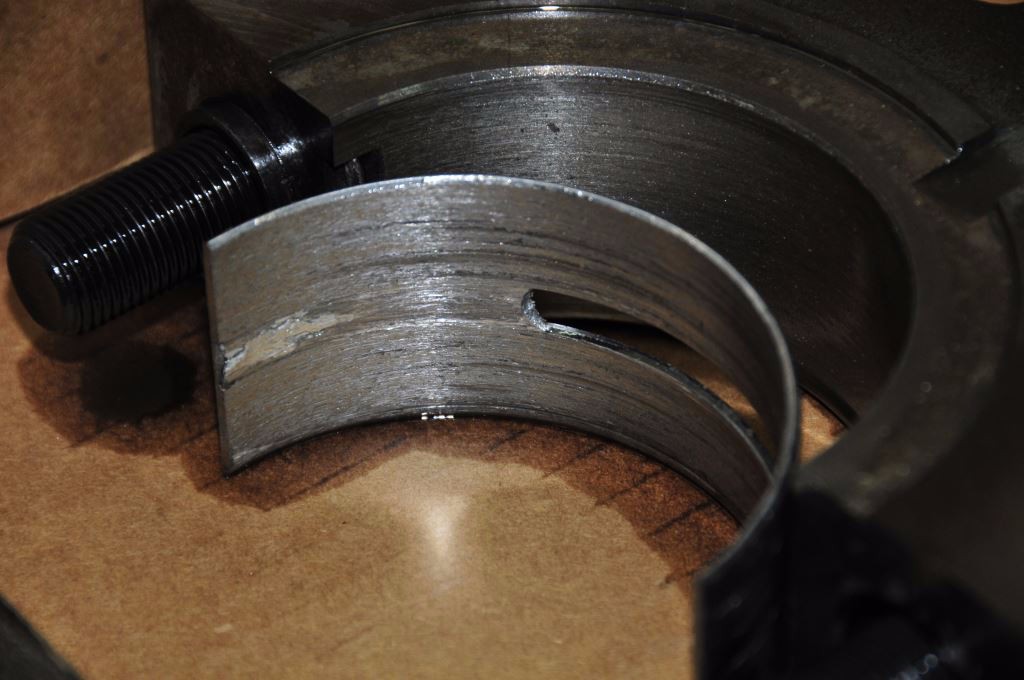
While the engine was in pretty bad shape, the shop was a gem.
In addition to the fact that the folks at this shop actually know how to repair and rebuild engines, rather than just sell them along with new parts, a seeming rarity these days, the attention to detail and cleanliness of the work spaces inspired confidence. As I noted to the owner in my note above, this sends a loud and clear message to customers, saying, “We enjoy our work, we are proud of it and we treat your stuff the same way we treat our stuff”. Oh, and the coup de grace, a Labrador retriever is on staff as well.
The shop, Trans-Atlantic Diesel, Inc., is owned and operated by an amiable Brit named Marcus Neville, he and his crew are the masters of, among others, all things Cummins Northern Lights Perkins, and Volvo. www.TAD123.com
This month’s column, the first of a two part series, covers the subject of hose clamps. I hope you find it both interesting and useful.
Hose Clamps Part I
Design and Selection
Photos and text by Steve D’Antonio
Copyright SDMC, Inc. 2015
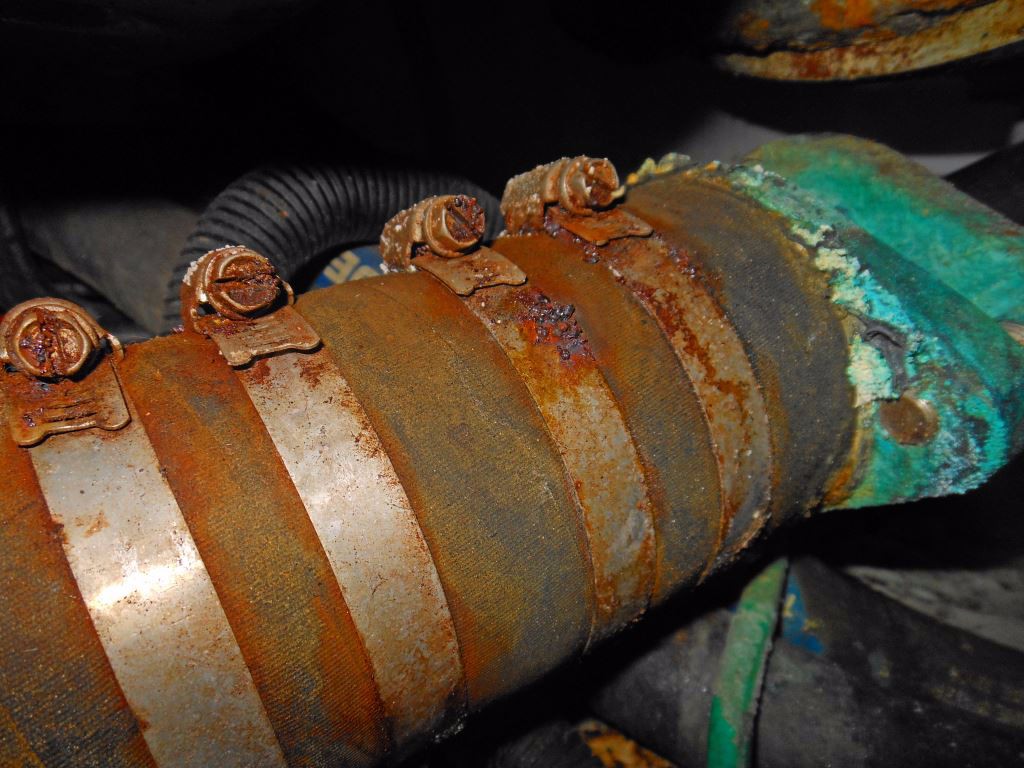
All hose clamps are not created equal, some are far more durable and corrosion resistant than others.
Think for a moment about this seeming incongruity, the watertight integrity of a vessel often relies on something as simple and mundane as a hose clamp, some of which cost less than a dollar. While I can’t say I’ve seen many vessels sink or suffer major flooding as a result of a failed hose clamp, I’ve seen enough to know it’s something I wish to avoid. Then, there are all the other important hoses that hose clamps secure, from fuel fill and supply plumbing to sanitation and potable water systems. Clamps that fail, or are improperly used, in these applications can lead to a host of maladies that range from inconvenient to catastrophic. Thus, there’s little doubt that this small component plays a big role in your vessel’s reliability.
Hose clamps don’t operate on their own; in order to form an effective hose seal, it’s important that they, and the hose, be used in conjunction with compatible, purpose made pipe to hose adapters. On far too many occasions, one nearly life threatening (more on that next month) I’ve seen hose connections fail because the hose was installed over a pipe fitting that was not specifically designed to support a clamped-in-place hose.
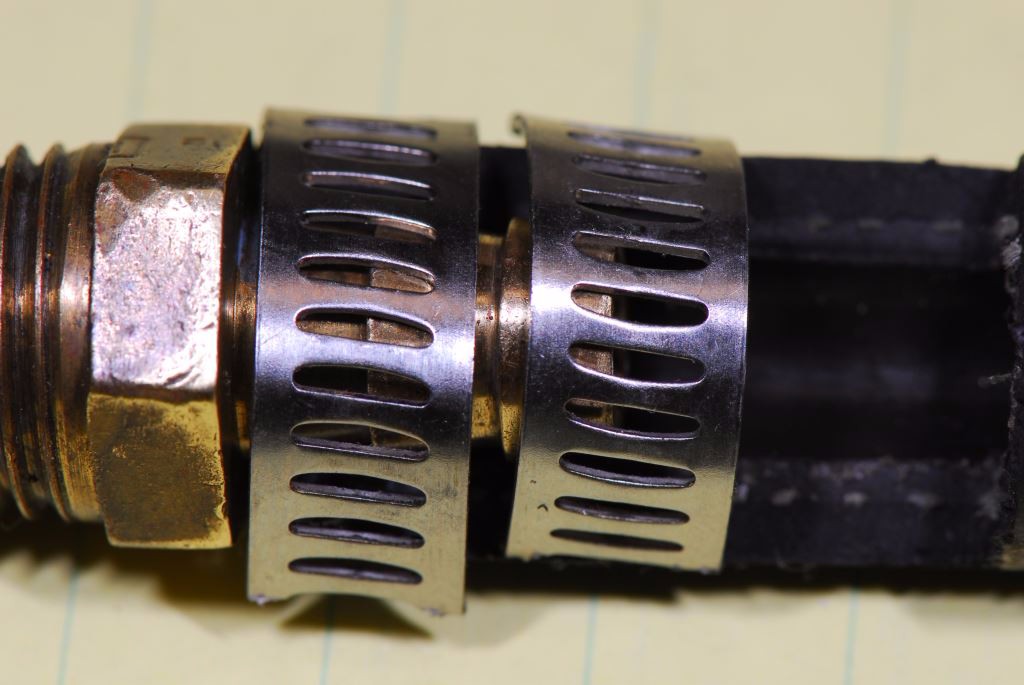
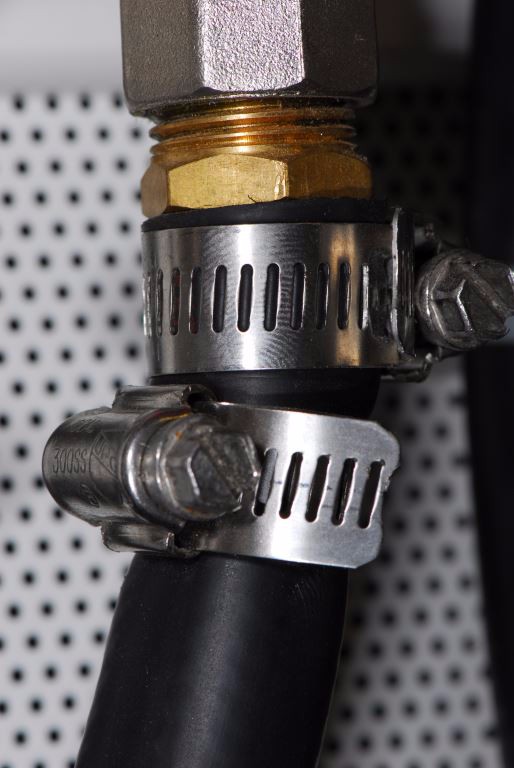
A common oversight involves the installation of two clamps where only one can fully bear on the pipe to hose adapter beneath. If the latter is too short to accept twin clamps, then only a single clamp should be used.
Hose Clamp Basics
The worm gear clamp has been around since just after WW I when its inventor, Commander Lumley Robinson, a retired Royal Navy officer, patented the first design in 1921. He called it a Jubilee Clip, a name that remains familiar to many Britons (as well as those who have worked on British automobiles). L Robinson and Company, along with many other manufacturers, continues to manufacture this venerable product to this day, with his Great-Grandson Ian Jennings (who I had the pleasure of meeting at the Marine Equipment Trade Show in Amsterdam last November), representing the 4th generation of the family, working alongside his father, John Jennings.
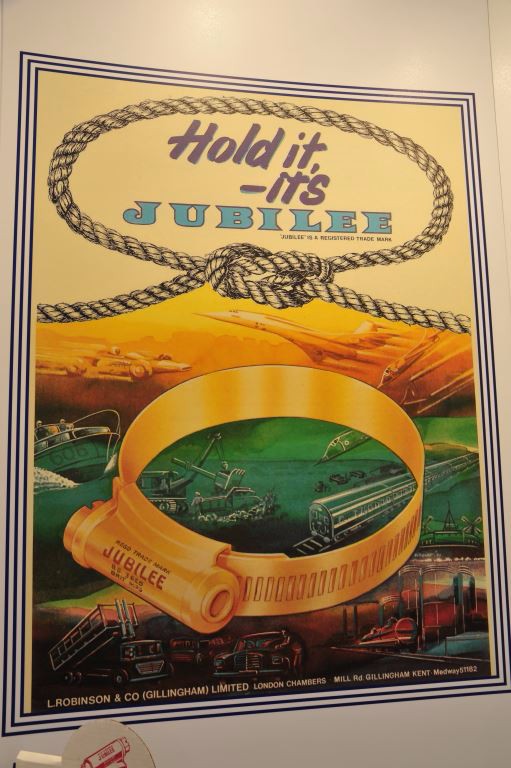
Where it all started; Many Brits still refer to hose clamps as “Jubilee Clips”.
The ubiquitous hose clamp, relying on a simple screw and threaded band arrangement is extremely effective at providing uniform pressure to hoses and the fittings over which they are placed. However, as respected as the original design may be, it isn’t without its flaws. Primary among these is the fact that many hose clamps rely on a series perforations that are cut into the band, to form the screw threads. These perforations eliminate a significant portion of the band’s cross section, weakening it and allowing it to elongate when tensioned. The elongation leads to micro-cracking, which in turn provides a toe hold for crevice corrosion, a form of metal decay that is peculiar to stainless steel alloy. When hose clamps part they nearly always do so across one of these perforations, either as a result of overstress or corrosion, or a combination of both. Additionally, the typical band itself is comparatively thin, which makes it relatively easy to strip the thread if the screw is over tightened.
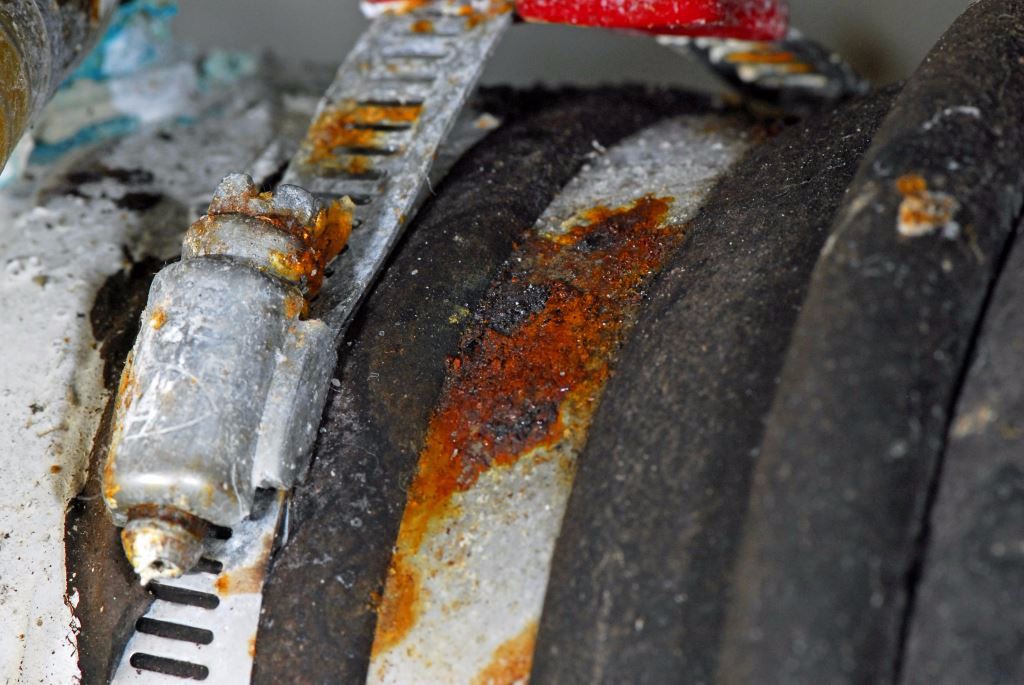
Conventional hose clamps, even those that are all stainless, can come to grief if exposed to the wrong conditions, i.e. continuously wet with seawater.
The typical hose clamp, what I refer to as an automotive clamp, is made of either a stainless steel or galvanized steel band (most clamps sold in the US utilize stainless steel bands) with a plated mild steel screw. In an automotive environment, depending upon the level of humidity, water and salt exposure these clamps can be expected to last for ten or twenty years. However, in a marine environment, the plated screw and galvanized band quickly come to grief and as such this style of clamp should never be used in a marine application.
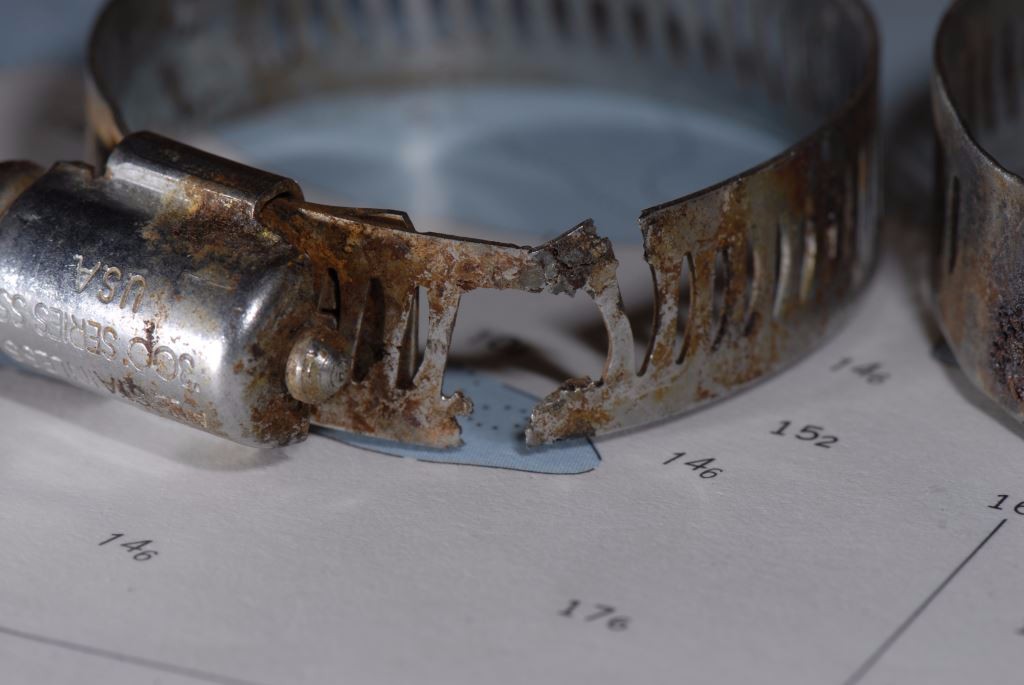
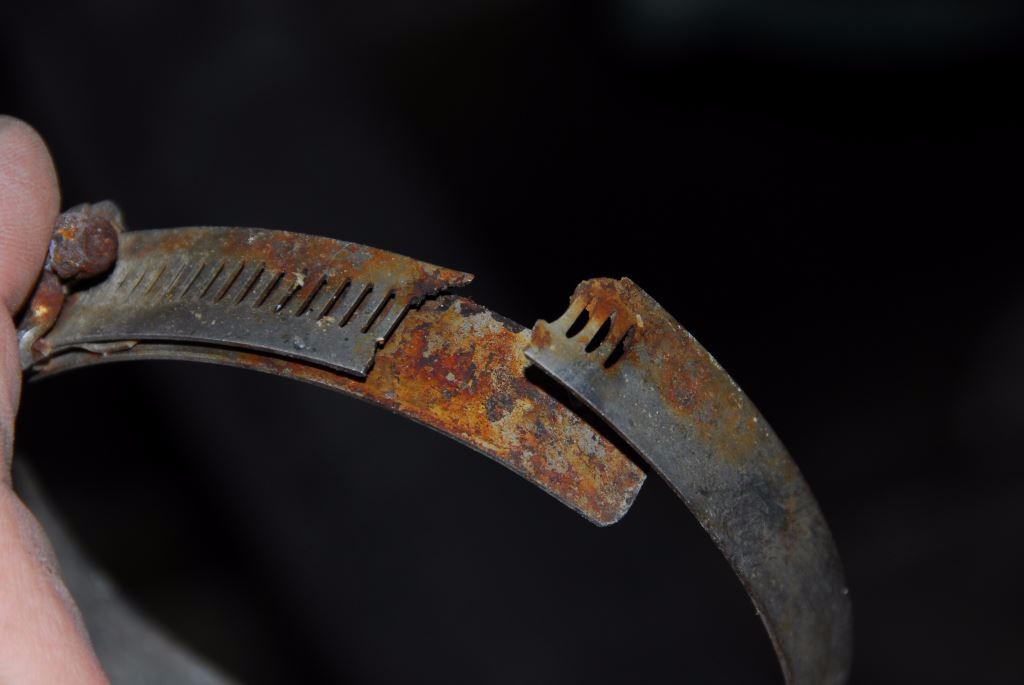
The perforated thread design in traditional hose clamps is often the source of corrosion-induced failures. Microscopic cracks develop adjacent to perforations, providing a toe hold for crevice corrosion.
Up-rated “marine” models with stainless bands and screws are available and represent a huge improvement over the automotive version; however, because they retain perforations and scant band thickness they too remain prone to elongation, crevice corrosion and stripping. In short, while they are better than the automotive variety there exists yet a better mouse trap.
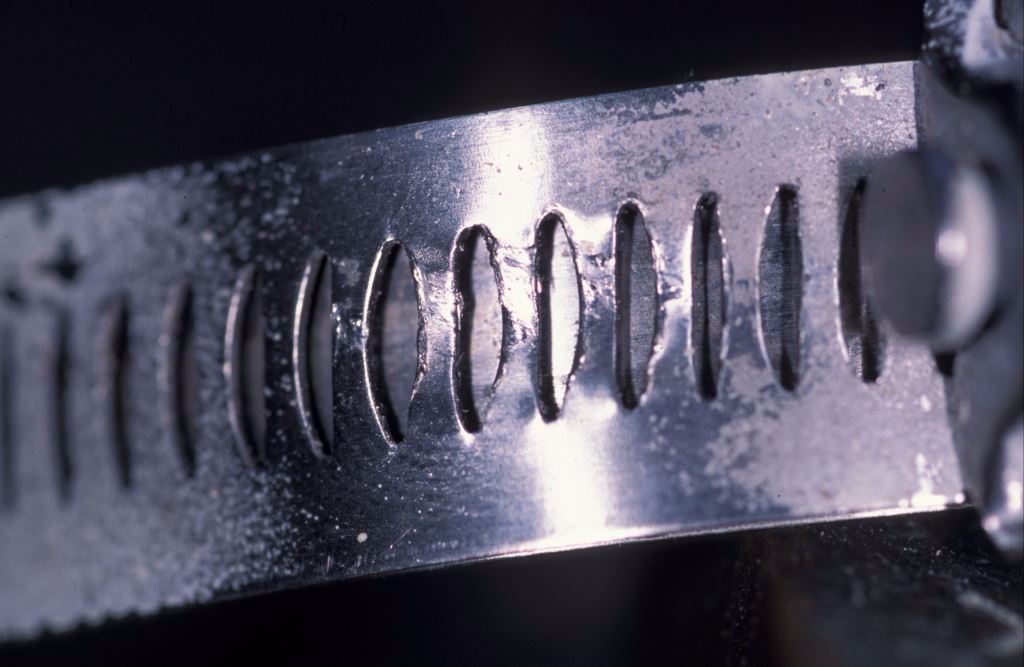
One of many weaknesses; conventional hose clamps rely on a thin band, perforations in which form threads for the clamping screw. It doesn’t take much over-tensioning to strip these “threads” ruining the clamp.
Hose Clamps Ready for Sea
Solid band, all stainless steel hose clamps represent a significant leap in both quality and reliability over both automotive and standard marine clamps. This style of clamp eliminates the band perforations, replacing them with embossed rather than perforated threads, necessitating a thicker band, which resists elongation, cracking and stripping. Solid band clamps are virtually immune to stripping even when over tightened.
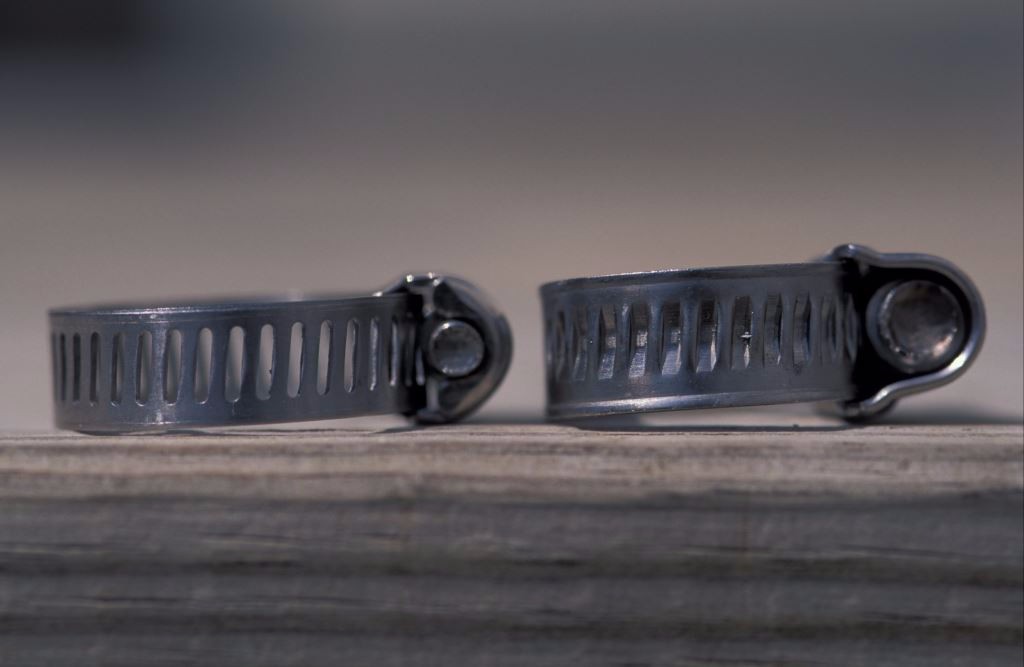
A conventional perforated thread design hose clamp, left, and a high quality, solid band clamp , right. The latter is nearly impervious to thread stripping and crevice corrosion.
These clamps are available from several manufacturers, including, among others Robinson’s Jubilee incidentally, and in a wide variety of size ranges. Importantly, while all stainless steel construction is a prerequisite for true marine clamps, clamps are often available in either 304 or 316 alloy, with a consequent difference in cost. For the most part, unless the clamp will be routinely submerged or exposed to water or spray, 304 alloy clamps will work well and cost the user less. In cases where maximum corrosion resistance is required, for stuffing box and bilge pump hoses for instance, then the added cost of 316 alloy clamps is easily justified.
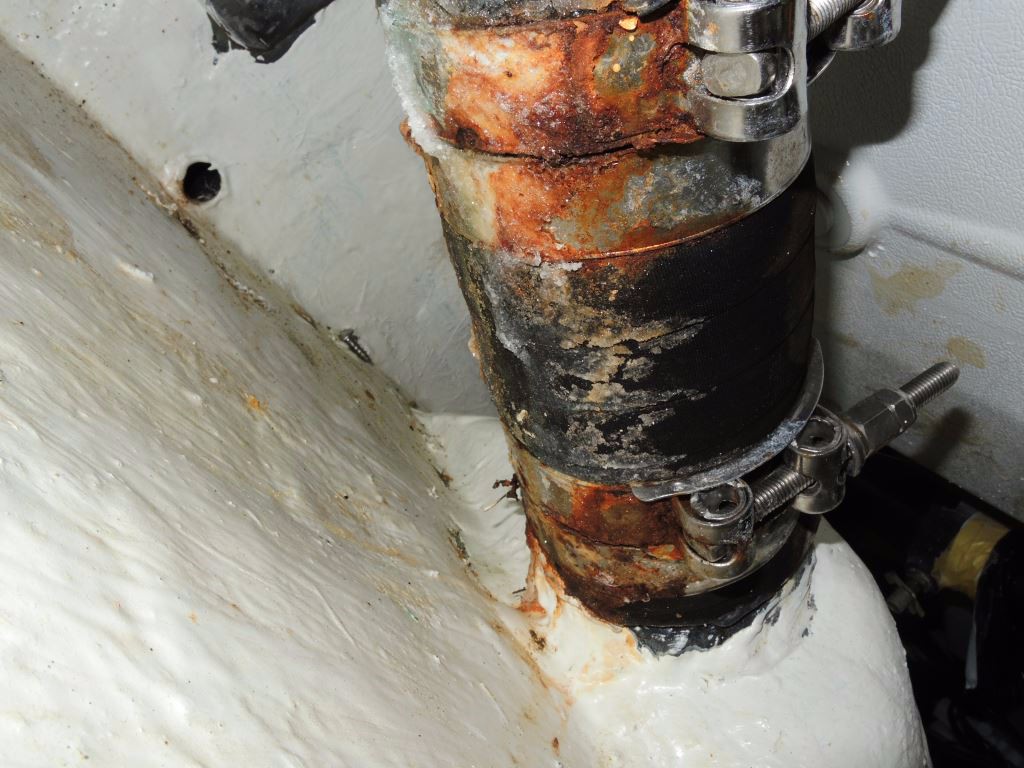
In many cases, hose clamps suffer the most where they can be seen the least; with the underside of stuffing boxes being a prime location for corrosion. These should be inspected regularly, using a mirror if necessary.
For especially large diameter or particularly stiff or thick hose, a slightly different variation on the traditional worm gear clamp may be required. T-bolt clamps utilize a conventional threaded machine screw-type fastener coupled with the traditional hose clamp’s band. The result is a clamp that is capable of imparting a higher level of compression over a wider surface area (T-bolt clamps are typically wider than most traditional hose clamps).
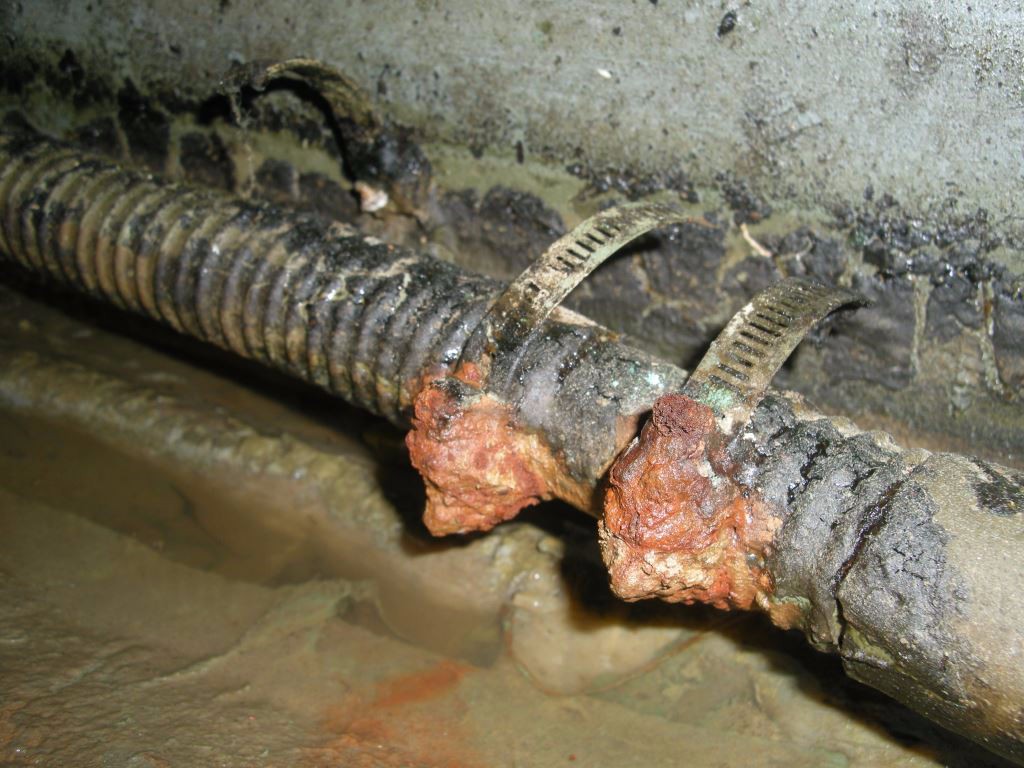
When used in continuously wet locations, like the bilge shown here, ordinary automotive style hose clamps, even those that are all stainless steel, simply don’t hold up. If the clamp screws are mild steel, like those shown here, severe rusting will often occur very quickly, often within a matter of months.
As useful and rugged as T-bolt clamps are, they possess their own weaknesses. Because they rely on a stainless steel stud and a stainless steel nut, they are prone to thread galling. Thread galling is common to all stainless steel fastener applications; it essentially amounts to micro welding as a result of heat generation within the threads as they are being tightened. This is easily prevented by lightly lubricating the threads before clamps are installed (if this hasn’t already been done by the manufacturer).
Another Achilles’ heel that these clamps possess is a function of the manner in which they are made. The T-bolt is retained by the band by folding the latter over and spot welding it to itself, creating an envelope of sorts. While this makes for a resilient retention method for the T-bolt, it also forms an area where water can be trapped, which often leads to crevice corrosion. If used in routinely used wet locations, such as shaft and rudder stuffing boxes, bilge pump plumbing etc, they are prone to crevice corrosion-induced failure.
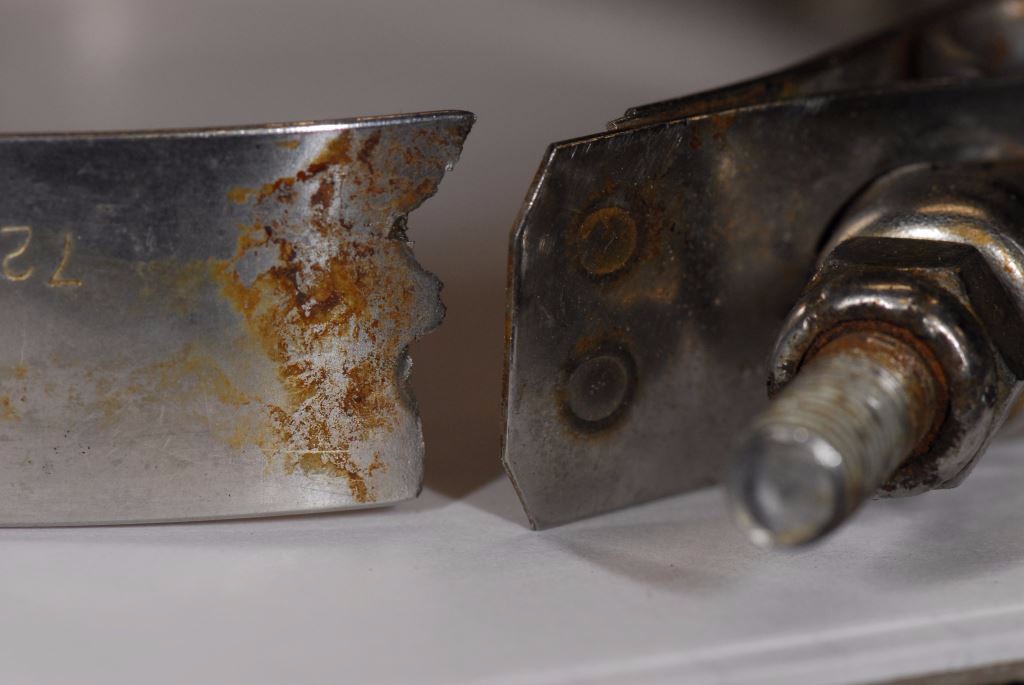
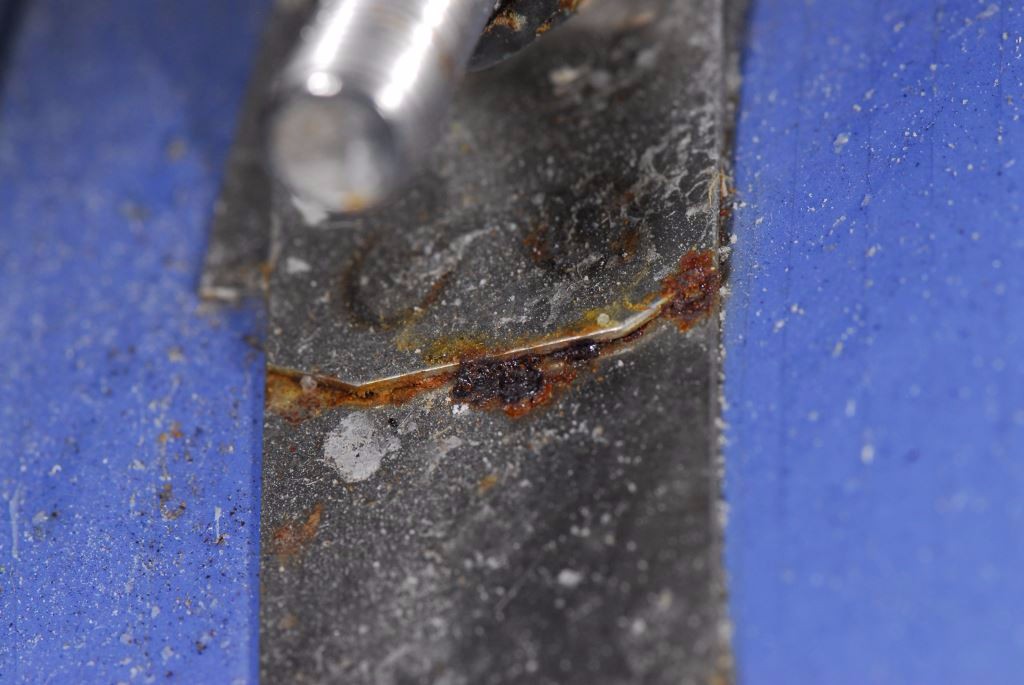
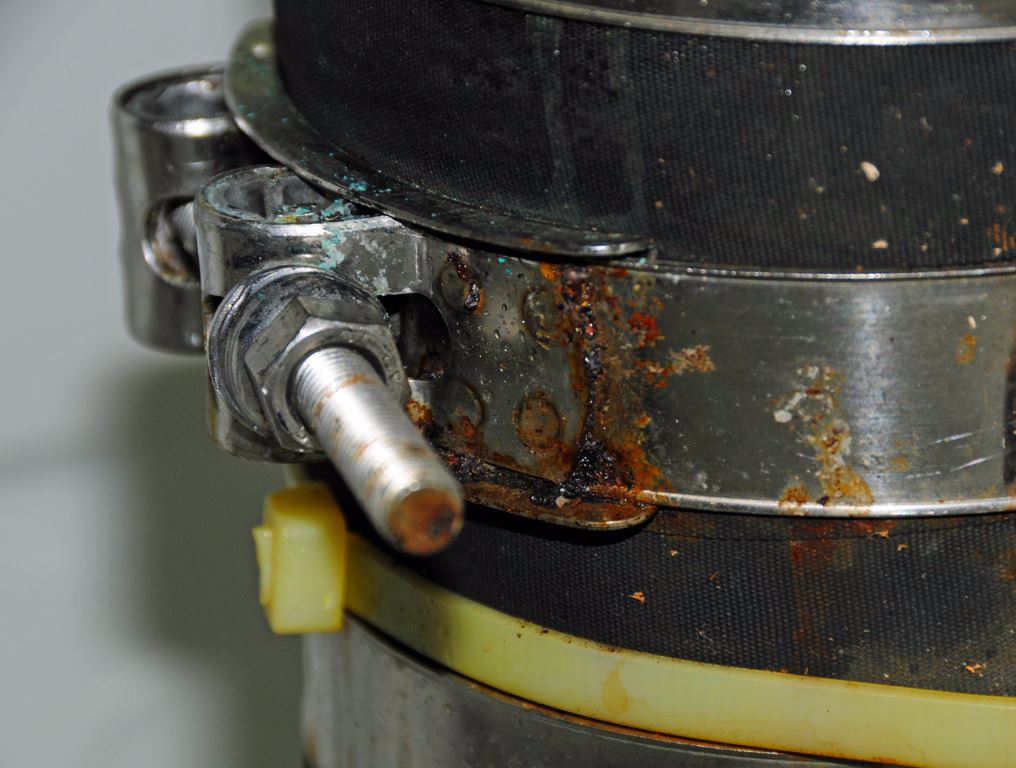
Thanks to their folded design, common T bolt clamps, those that rely on a threaded bolt and nut for clamping, are susceptible to crevice corrosion.
Because necessity is the mother of invention, a manufacturer named AWAB (they also manufacture high quality solid band hose clamps, in 304 and 316, as well) has created a T-bolt clamp that uses interlocking rather than folded and spot welded bands, virtually eliminating the water-trapping fold and the corrosion to which it so often leads. These clamps are well suited to wet locations without concern for such failures.
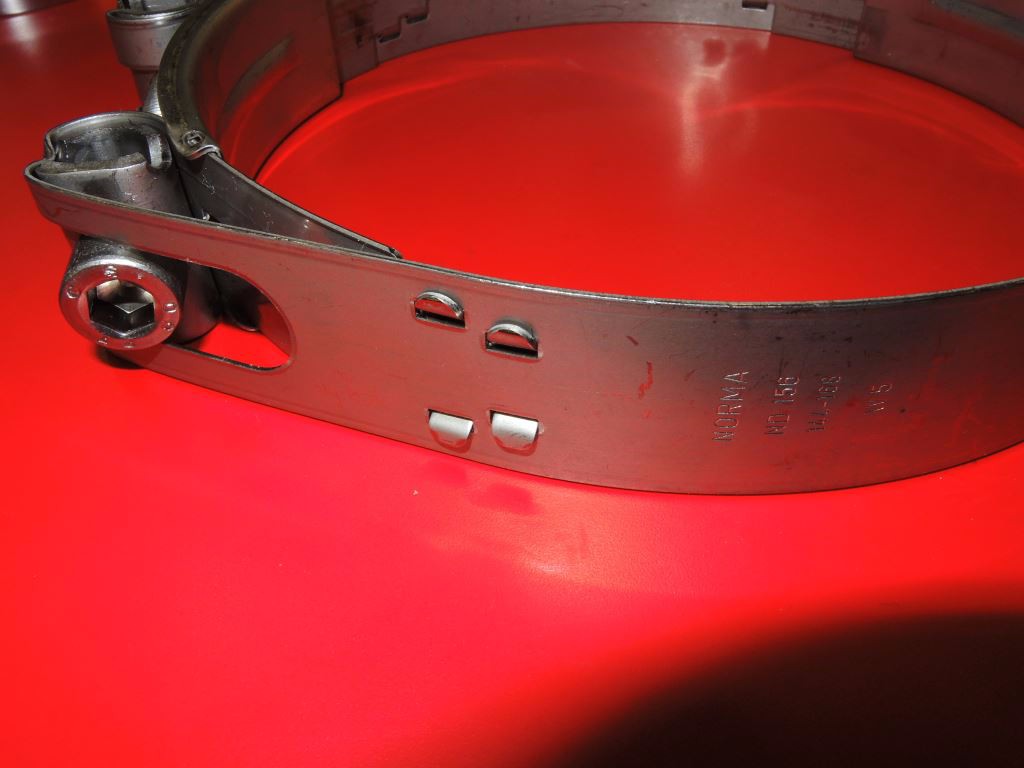
An improvement on the T bolt design does away with the spot welded fold, replacing it an with interlocking mechanism. The result is greater resistance to water entrapment and corrosion.
When it comes to hose clamp selection, don’t skimp on this ultra-important component. Clamps must be all stainless steel, 304 for “dry” applications and 316 for wet, with solid, embossed thread bands.
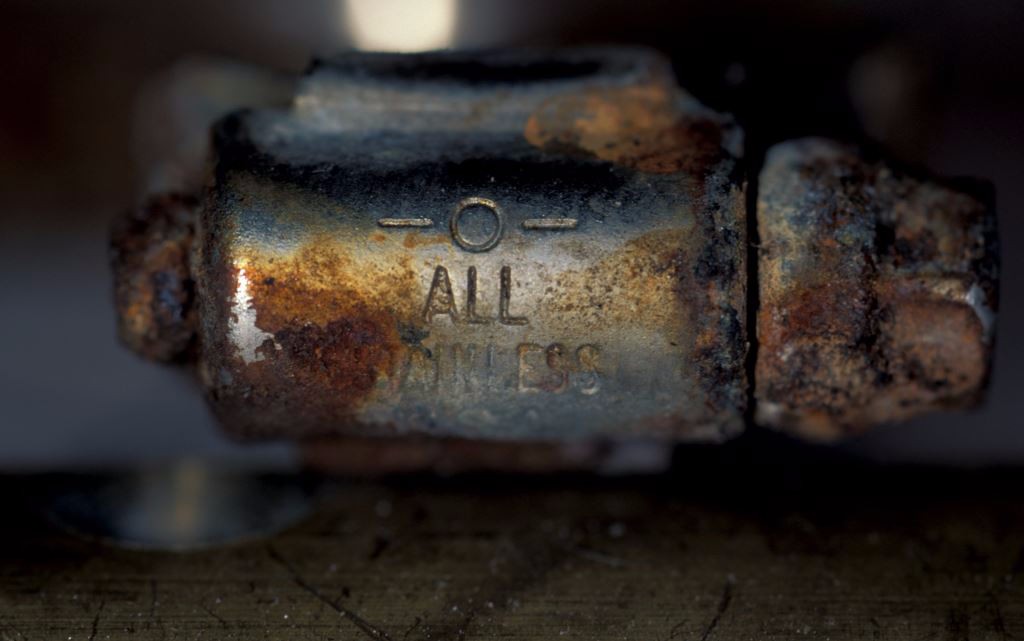
While this automotive-style clamp is embossed, “ALL STAINLESS”, it is in fact a hybrid, the band and screw retainer are stainless steel, while the screw is mild steel.
Next month I’ll discuss hose clamp installation, pipe to hose adapter dos and don’ts and how an improperly installed hose nearly resulted in me being seriously injured.


